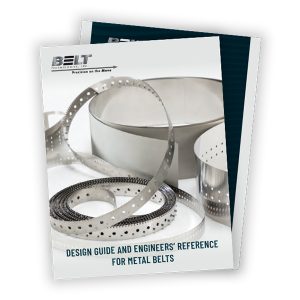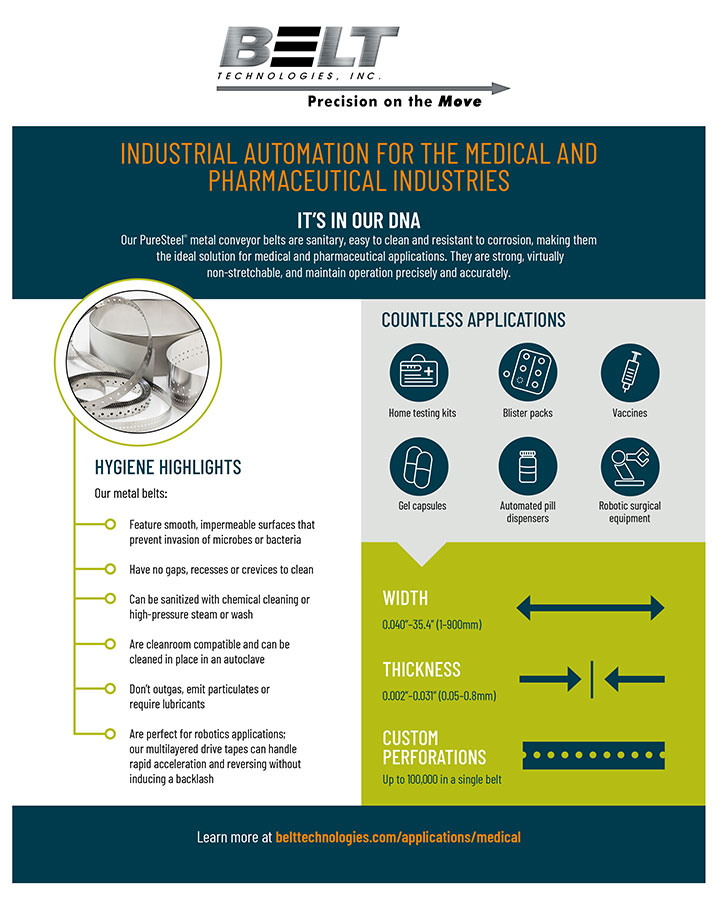When it comes to selecting the right conveyor belt material for your operation, there is no shortage of options. Belts have traditionally been made from PVC, nylon, cotton, polyester and metal, among other materials. The number of choices may be overwhelming, but we can help narrow it down by explaining how our PureSteel® metal belts provide many unique benefits and advantages to overcome any manufacturing challenge.
The Downsides to Cloth, Plastic and Metal Mesh
Fabric and plastic belts—including those made of nylon, cotton, polyester or polymer—have several major drawbacks, including inconsistent tracking and inadequate hygiene. Like PureSteel®, most fabric belts rely on friction for forward driving, but tracking can become an issue for these lesser materials as the belt slowly moves off the center of the track. Additionally, both fabric and polymer belts are easily frayed and allow for bacterial buildup in crevices and small holes. This requires that they be regularly removed for cleaning, negatively impacting productivity.
Another belt option combines minuscule metal chain links in a mesh pattern. While this concept affords the inherent benefits of stainless steel, it presents another drawback. These belts consist of many connected parts, so lubrication is required to avoid generating friction between the elements. This introduces another contaminant into your operation and presents a risk to the cleanliness of the products in your facility.
The Many Benefits of PureSteel
No matter your manufacturing challenge, our single-element, stainless steel belts are up to the challenge. These are just a few of the ways they outperform the competition:
- Accuracy. To ensure the most accurate and reliable motion possible, PureSteel® metal belts are manufactured to dimensions with very tight tolerances. This focus allows us to fabricate metal belts with a pitch accuracy of ±0.0005”.
- Customization. Metal belts can be customized with perforation patterns, attachments and surface coatings. This variety of options means we can design a specific belt to meet your needs, even for the most unique projects.
- Durability. The metal’s nonporous surface resists damage, a benefit for applications where food bacteria or other germs could proliferate in grooves, marks or scratches.
- Hygiene. Other conveyors can be very difficult to clean, requiring either periodic removal from the production equipment to immerse in chemical solutions or the installation of complex cleaning systems and brushes. In comparison, stainless steel belts can be cleaned-in-place with almost any cleaning or sterilization method.
- High strength-to-weight ratio. Stainless steel has a tensile strength ranging from 180 to 300 KPSI, depending on the alloy and temper chosen. Relatively thin and lightweight belts can be designed to handle the stresses of almost any application.
- Non-stretchable materials. Compared to belts made with other materials, metal belts made with spring steels have a high modulus of elasticity, so they don’t stretch.
- Thermal conductivity. Metal belts are better at absorbing and transmitting energy in the form of heat, cold and electricity, which are often used in the manufacturing process.
The Perfect Solution for Your Facility
Our team has perfected the engineering of our PureSteel® belts, so you can trust us to design a unique belt to meet your exact needs. This includes a broad array of metal alloys, belt width and thickness combinations, perforations, patterns, coatings and attachments.
Our engineers will work with you to find the right belt for the job and create a custom solution tailored to your facility. Contact us to learn more.



